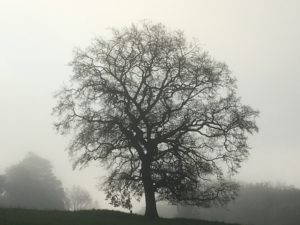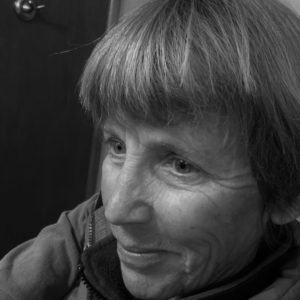 The first camera I owned was a pinhole camera. I made it myself at summer camp in New Jersey. It was 1963, the year of a July solar eclipse, and the good people of Camp Red Ram came up with a plan to keep us from looking directly at the sun. We’d spent many days making keychain lanyards and plaster casts of raccoon prints. We learned how to sew our own pup tents from material donated by our mothers. But now, with a small cardboard box and a piece of white paper, we’d make a contraption to watch the eclipse. Simple. Glorious. The sun and moon caught inside a camera constructed by me.
The first camera I owned was a pinhole camera. I made it myself at summer camp in New Jersey. It was 1963, the year of a July solar eclipse, and the good people of Camp Red Ram came up with a plan to keep us from looking directly at the sun. We’d spent many days making keychain lanyards and plaster casts of raccoon prints. We learned how to sew our own pup tents from material donated by our mothers. But now, with a small cardboard box and a piece of white paper, we’d make a contraption to watch the eclipse. Simple. Glorious. The sun and moon caught inside a camera constructed by me.
After that came a Brownie, a camera named, for reasons unknown, for the small nocturnal folk who rid your house of spiders and harass milkmaids. It was a plastic cube you held up to your eye, and when you pressed the shutter button to take a picture there was a satisfying click. That was followed shortly by a flip-top Brownie that hung awkwardly around your neck by a strap. You looked down into it and tried to keep the camera from swinging as you took the picture. It wasn’t a successful design and soon enough along came the Instamatic. Unlike Brownies, Instamatics had a film cartridge. You simply opened the back and popped it in—no going into dark closets to unload and reload your Kodak film. My Instamatic had a wristband and I carried that camera everywhere, the comforting weight of it swinging by my side.
I remember seeing a Dennis the Menace cartoon at the time. I didn’t always read “the funnies” as my dad called them, but my memory of this cartoon is still with me. Dennis has taken a picture with a Polaroid camera and he proudly shows his mother the result. The photograph is a close-up of the inside of a dog’s mouth. His mother looks bemused, but when I saw it I knew I wanted to take photographs just like that. It was a way of recording the world as I understood it, a world of details and unexplored perspectives. I was happy to capture the moon in my camera, but what about the underbelly of the moon, the dark or vulnerable side, the side unseen?
In high school I started using a Pentax single-lens reflex camera and spending time in the darkroom developing my own photographs. To stand in that small, airless room that smelled of sweat and vinegar and to watch the shadowy images slowly take form in the chemical bath was a kind of magic I could not articulate. And the fact that it was almost impossible to speak of, when everything else in my life was attached to speech and naming, saved me. Which made the abrupt end to that time enduringly painful.
It happened like this: We met in the oral surgeon’s office, both of us having our wisdom teeth out. He was a professional photographer and I was on my way to college, feeling the pull of the dark room and those ghostly images in the tray. Maybe a major in photographic journalism? Maybe a journey down the avenues of art? I didn’t know yet. I didn’t need to know. He was an interesting man to talk to and his insights about his profession were helpful.
After our teeth were removed he invited me for coffee and a visit to his office to see his photographs. It was a Sunday. I went. His office was on the twelfth floor of a large downtown building and not one other person was around. He closed the door behind us. The blinds were pulled and though he kept up a constant chatter the silence was terrible. He asked me to unbutton some things, all my things, and sit down. I felt it would be a good idea to do as he asked and I did. I sat in front of his desk and noticed that I was shaking and noticed that on his desk there was a camera, a Pentax like my own, and it was pointed directly at me. It was only later, when I made myself look at his photographs on the wall, that I understood why I was there. I was young looking. At seventeen, in dim light, I might have passed for twelve. He was blunt. He nodded at the wall and said, “At their age I have to get parental permission to use those photographs, but you’re not a minor.”
So the stream of creativity and joy in the visual world came to an end. It stopped abruptly. For 45 years I never took a picture nor posed for one, though I have seen some photographs from that time in which I look like a snarling, captured animal. I understand now that photography is a tool in our hands, and the nature of the hands that use it determine its power to harm or heal. We use a camera to record, to hide behind or to see. I have recently begun to take pictures again and I do it now as I did before, in order to look, to see.
In the past, when I held a camera to my eye there was a sense of being at the center of the universe, a sense of witnessing a universe that had shrunk down in magnitude from its limitless self to a phenomenon that could and did fit inside the small frame beheld by my eye. A narcissistic sense of power came over me, though it seemed benign enough. When I photographed something, anything, I felt it was in service to beauty and in some form truth.
I know now that the moon has an underbelly and to show this is also in service if not to beauty at least to truth. Writing is a kind of camera. The word itself comes from the Latin camera obscura, or dark chamber. I think of it as a chamber of the heart. For the heart informs the eye as the eye informs the heart. My first camera, the pinhole, was a simple box that led to other more complicated boxes that opened up a world of unexpected troubles. To write those troubles here, to expose the underbelly, is to open the door to the heart’s chamber, to the eye of truth and the eye of beauty that seeks and finds in a wet morning field the lone oak saying Look at me, look at me.

